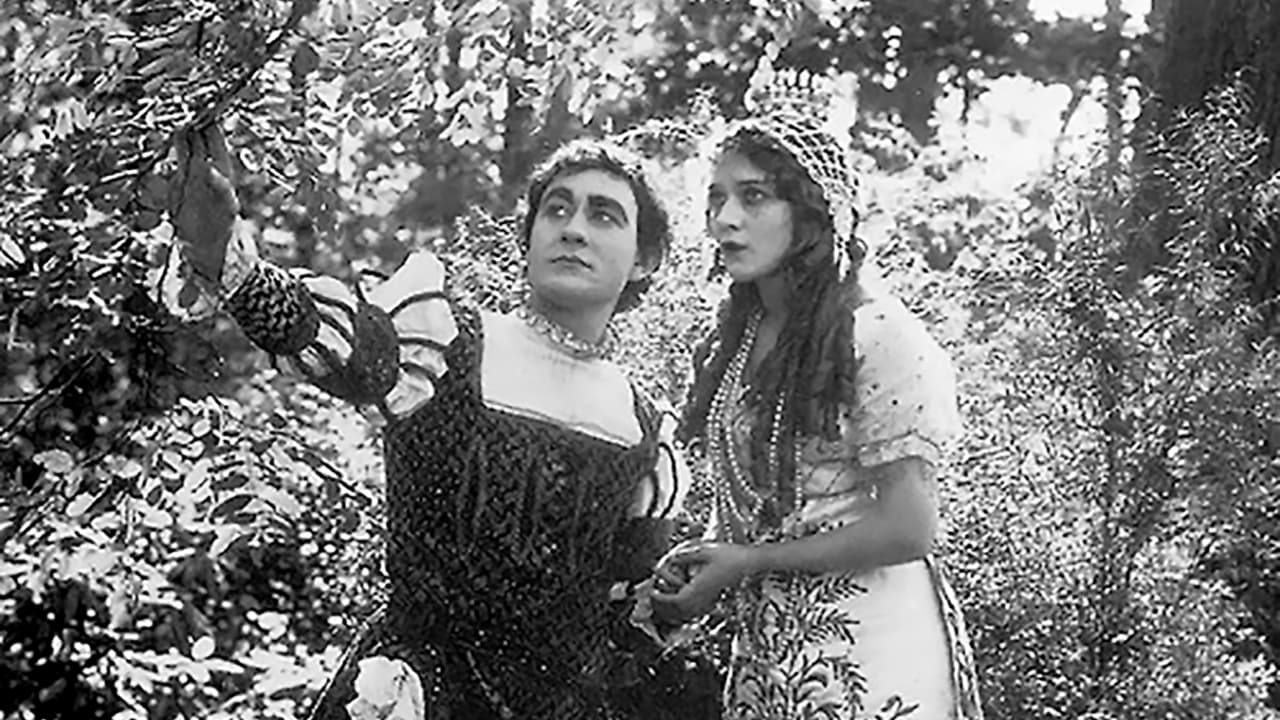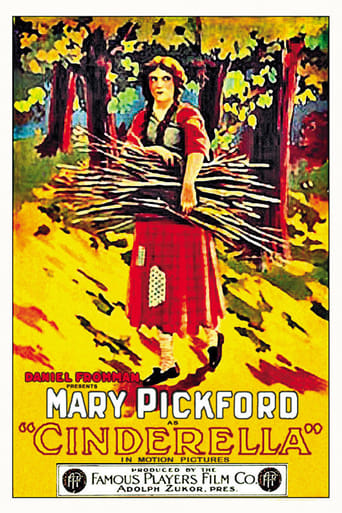


Who better to play Cinderella than the most beloved star of the time, Mary Pickford. This adaptation of the popular fairy tale was long considered lost, until the film was discovered in the Nederlands Film Museum. Famous Players production of the story is straightforward as they had hoped it would appeal as much to adults as to children, and planned it's release for Christmas 1914. Beautifully filmed on impressive locations in Greenwich, Connecticut, permission was obtained to shot at some wealthy homes, very effectively creating the Royal Palace and it's grounds. They incorporated some trick photography that is considered standard for the time when compared to the highly advanced work of French filmmaker George Melies. The strong lighting and tinting of this film gives it a dreamy watercolor effect. But as always, it is the charms of Mary Pickford that makes this film extremely delightful. With her unique naturalness, she adds such lovely little touches, such as tickling the footman to see if he is real after being transformed from a rat. With her expressions and gestures, Pickford is able to give Cinderella a personality, that is most engaging. She is even enchanting as she carries cages full of mice and rats for her fairy grandmother to change into horses and footmen, and Pickford looks exquisite in her gown as she travels to the Prince's ball. Owen Moore, Pickford's husband at the time plays the role of Prince Charming fairly well, and the stepmother and sister's are adequately performed by Isabel Vernon, Georgia Wilson, and Lucille Carney. I consider this 1914 version of Cinderella, a little masterpiece among early silent films. I was surprised how intrigued my two preteen nieces were while watching this film, and feel that is a strong testament, to the fact that this Cinderella is still able to bring delight and entertainment nearly one hundred years later. For anyone who appreciates early silent films and the art of Mary Pickford, this early film is a must see.
... View MoreThis film is included as a DVD extra for another one of Mary Pickford's films, THROUGH THE BACK DOOR. Both have very well-preserved prints and nice musical scores--making this DVD well worth having.In many ways, this film differs from the traditional Cinderalla story. However, these differences generally help the story and make for an excellent film.Unlike the more traditional story, this time the Fairy Godmother comes to Cinderalla before the ball. She's dressed like an old lady and Cinderalla is kind to her. So, the fairy and all invisible fairies nearby all decide they should do something nice for her.Additionally, I was surprised to see that she actually met the Prince before the ball as well. While she was gathering wood, she slipped and the Prince came to her aid--even though all the noblemen with him seemed to think that Cinderalla was just some dumb peasant. I liked this, as it game the Prince more depth. I mean, think about it, in most versions he sees her just once at the ball and pledges to marry her because of love at first sight! What a dope! But here, there is a greater depth to him and the story.Naturally, the Fairy Godmother does show up and makes Cinderella beautiful for the ball. And, naturally, the Prince is quite smitten with her. And, naturally, she runs away and the Prince vows to marry the woman whose foot fits the magic slipper. All this is pretty standard, but you certainly could NOT expect them to change these details. But, in an interesting twist, the Prince immediately recognizes Cinderella when he finds her dressed in rags and is delighted. Sure, he puts the shoe on her, but this is after he's taken her to the castle to show his father, the King. This, also, seemed like a nice way to tell the story. The Prince in this tale is no vacuous pretty-boy! One thing that the story did not do (and I doubt any movie ever did show this), but according to my daughter who studies folklore in college, in one version the wicked step-sisters do some insane things to try to claim the shoe is theirs. They saw their toes off and horribly deform themselves to try to get it to fit!! I would just love, for once, to have that included in a film--though it might just traumatize the kids watching it.Overall, you might be surprised to hear this, but I truly think I enjoyed this more than the more famous Disney and Rogers-Hammerstein versions. It's sweet and well-told but unfortunately forgotten since it's "only a silent film" as some knuckleheads might think, few will probably get around to it.
... View MoreReally this film isn't very good, but echoing another comment I made somewhere on here, don't you think making movies used to be more fun? The ugly sisters played by a bunch of ridiculous men? The gaggle of silly kids that are the forest fairies? they must have had a blast! I guess because these weren't considered art there was no pretension that they should be classy. the tone of it was a little like a john waters film. The trick to enjoying a film like this is to forget how important movies are to us, as people, as a culture, as individuals. I tell people I'm an independent film maker and generally the regard that either like I must be crazy or like I'm doctor or something, which is cool, but imagine back in the days when you'd have been treated like hustler like a pimp, how could you treat yourself that seriously? Anyways, this movie is pretty much totally dumb, but so is Cinderella. The whole shoe thing? He falls in love with a girl who he's never met and doesn't even get a name out of, and decides to track her down by having every woman in the land try on her shoe? so why didn't the shoe turn back into a pumpkin or squash or whatever? no one in the kingdom had Cinderella's shoe size? if he never met her but she was dressed like princess wouldn't it be a safe assumption that she's not actually in your kingdom? royalty tends to know the other royalty nearby. and also if he's so damn in love with why can't he pick out her face? it can't have looked that different without the accoutrement of the ball. also: he's going to marry a peasant? is he crazy? the king and queen don't want him to use that marriage for something beneficial like making peace or pooling power with allies? all the while everyone knows he probably could have just hired poor Cinderella, put her up at the castle and had his way with her any time he felt like it, which is pretty much what royalty did back then. for example henry the... what the crap was I saying? I got distracted. oh, yeah. I would give anything to have worked on a movie like this. but that doesn't mean you'll enjoy the movie per Se.
... View MoreIn its time, this must have been the longest and most ambitious screen version of the familiar story of "Cinderella". So many later versions have been made with the advantage of more recent technology that a 1914 version could never be expected to meet the same standards, but it's a good version for its time, and it stars Mary Pickford in a good role for her. Other than moving a bit slowly at times, almost everything about the feature is of good quality by the standards of its era.Pickford is certainly well-cast as Cinderella, in one of her earliest full-length movie roles. It's no accident that she would eventually play characters like Pollyanna, Rebecca of Sunnybrook Farm, and so many other similar roles. She was able to make such characters instantly sympathetic and believable, and her attractive appearance and engaging personality worked well in many different situations. Her later features would give her a wider variety of material to work with than this does, but she does well here with each scene.Owen Moore, who was married to Pickford at the time, plays Prince Charming. Moore does not have much range as an actor, but he has a good silent screen presence, and that is what this role most calls for. The two mean-spirited stepsisters seem to be played (despite what the posted cast list may imply) by two male actors, giving the characters a humorously ugly appearance and humorously ungainly movements.There are numerous visual effects, and director James Kirkwood made an interesting choice by filming most of them with gradual dissolves rather than with the stop-motion, sudden change technique that was more common. Neither method is necessarily better or worse; they are just different in the effect that each creates. There are also some good dream effects, especially an amusing sequence after Cinderella misses her midnight deadline.For the most part, only silent movie fans will have any significant interest in this. But if you can evaluate it by the standards of its own time, it's a pleasant little movie and a chance to see the charming Mary Pickford while she was in the process of developing her many talents.
... View More